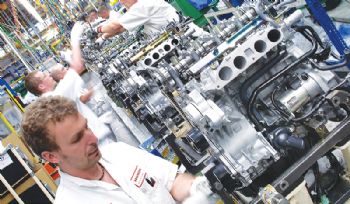
According to the IHS Markit/CIPS Purchasing Managers’ Index (compiled 13-27 November), November saw the UK manufacturing sector ‘move up a gear’, with rates of increase in new orders and production among the best registered over the past four years.
The seasonally adjusted PMI rose to 58.2 in November, up from 56.6 in October — its highest level since August 2013, with companies linking this to stronger inflows of new orders, reflecting solid domestic demand and steeper gains in new export business.
Some companies reported higher sales in Europe, the Americas, Asia and the Middle East; there were also reports that the weak sterling exchange rate continued to boost export competitiveness
.
Backlogs of work at UK factories increased for the first time in six months during November, with ‘tighter capacity’ — combined with rising demand — encouraging companies to increase employment (staffing levels rose for the 16th successive month, with the rate of jobs growth the highest since June 2014).
Rob Dobson, a director at IHS Markit (which compiles the survey) (
www.ihsmarkit.com) said: “UK manufacturing shifted up a gear in November, with growth of output, new orders and employment all gathering pace.
“On its current course, manufacturing production is rising at a quarterly rate approaching 2%, providing a real boost to the pace of broader economic expansion.
“The breadth of the rebound is also positive, with growth strengthening across the consumer goods, intermediate goods and investment goods industries. Of real note was a surge in demand for UK investment goods, such as plant and machinery.
This suggests that capital spending — especially in the domestic market — is showing signs of renewed vigour.”
Duncan Brock, director of Customer Relationships at the Chartered Institute of Procurement & Supply (
www.cps.org), said: “As the impact of the weak pound diminished, businesses were turning their attention to new opportunities, clients and investment, as business optimism was up from October’s four-month low.
"However, this increase in demand meant suppliers fared less well, as delivery times continued to lengthen amid the scrabble in demand and raw-material shortages, leading to further rises in input costs for manufacturers, which were then passed on to customers.
“The domestic market remained strong, but new export orders — primarily from the USA and Europe — were a big part of this overall picture of success. Job seekers were also winners, with the strongest rise in employment since June 2014 plugging the gap in growing capacity issues.”